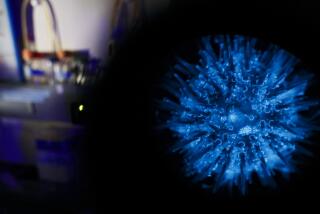Pet micro pigs? Chinese biotech firm says it will sell very small swine
- Share via
Reporting from BEIJING — Have you been pining for a “teacup” pig but worried that the supposedly petite porcine pet might grow as big as your bathtub?
A Chinese biotech firm says it now has the answer: a genetically modified swine that tops out around 33 pounds.
BGI, a company based in the southern city of Shenzhen that is known for its work sequencing human, plant and animal DNA, recently announced that it intends to start selling $1,600 miniature pigs that it initially created as laboratory models for studying human ailments.
The pigs created a splash late last month when BGI showed them at the Shenzhen International Biotech Leaders Summit. The pint-size porkers were created through a process known as gene editing. Rather than introduce another organism’s DNA into the pigs, scientists “edit” the swine’s own genetic material, disabling a copy of the growth hormone receptor gene so that cells don’t get a signal to grow.
SIGN UP for the free Great Reads newsletter >>
Swine-loving celebrities will have to wait for further innovation for truly purse-portable pigs (Miley Cyrus’ Bubba Sue and Paris Hilton’s Princess Pigelette are more than a handful, while George Clooney’s 18-year companion, Max, grew to 250 pounds before he died in 2006).
But animal breeders and advocates say the prospect of even a 33-pound pig could reduce the problem of people abandoning pet swine that pack on the pounds beyond their owners’ expectations. Curt Mills, a board member of the Southern California Assn. for Miniature Potbellied Pigs, says four regional shelters for the animals are all at capacity, with about 150 oinkers looking for homes.
“Pigs are good pets, but a lot of issue is the size,” said Patty Morrisroe, a pig breeder in Dallas, Ore., who says she has spent 30 years selectively breeding swine to produce pigs she calls “Royal Dandies” and “Dandie Extremes” that can be around 39 pounds full grown. But with just four breeding sows, her litters are limited — about 20 piglets a year — and she charges $2,500 to $5,500 per animal.
“If you could immediately make a small pig, it would be very cool, but there are still a lot of questions,” she said.
Kenneth Bondioli, a professor of animal sciences at Louisiana State University, said BGI’s gene-edited micro pigs would need to be evaluated to see if they develop healthily and to determine whether they would could harm the environment or other livestock if they were released or escaped. It is unclear whether BGI intends to offer its pigs for sale outside China, but if Americans wanted them, U.S. regulators would have to determine whether they could be imported.
“If these and other questions are addressed, the fact that they are gene-edited is irrelevant,” Bondioli said.
Researchers say the creation of micro pigs could be a boon for scientists, cutting down on the cost of raising them as laboratory animals and making their care more manageable. “Their utility for research will depend on whether they are otherwise normal like a regular pig and unaffected by the edited gene other than their diminutive size,” said Willard Eyestone, an associate professor of biotechnology at Virginia Tech.
These micro pigs could be useful “especially for long-term studies, during which even currently available ‘mini pigs’ grow to substantial size,” he said.
But Alison Van Eenennaam, a biotechnology specialist at UC Davis who visited BGI about three months ago and saw their micro pigs, said the fact that the company has resorted to marketing them as pets reflects the “global regulatory gridlock” around gene-edited animals for food production and other more serious purposes.
“Genome editing is a powerful technology that can be used for many beneficial applications … such as producing disease-resistant animals and other things that would have real benefits for the sustainability of food production,” she said. But worldwide, she said, no genetically engineered animal for food production has been able to be brought to market, and only a few genetically engineered animal therapeutic products have been approved for humans. That, she believes, is making companies hesitant to invest in the technology.
Bioengineered pets, though, have found easier acceptance. A transgenic florescent fish, marketed under the brand GloFish, has been popular for a number of years in the United States. The fish were created by Singaporean researchers who inserted jellyfish and sea anemone genes into zebrafish eggs.
“People are happy to have them in their aquarium, but it’s when it’s on their dinner plate that they have a different attitude,” said Van Eenennaam.
A company called AquaBounty has been seeking for more than 20 years to win FDA approval to bring a genetically modified fast-growing salmon to supermarkets. Whereas the AquAdvantage salmon and the GloFish have been engineered to incorporate genes from other fish, the technique used by BGI to create its micro pigs is different and presents a new question for regulatory agencies such as the FDA if they were to be imported to the United States.
Pigs are technically food animals, said Max Rothschild, an agriculture professor at Iowa State University, and the FDA reserves the right to regulate any genetic modification introduced into such organisms. But in sharp contrast to genetically modified organisms with DNA added into their genomes, he said, the micro pig was made by removing just a few, highly targeted letters of DNA from its own genome.
“The FDA should be grappling with this major difference right now as to how it will affect regulatory policy,” he said, “and whether gene-edited organisms should be regulated in the same way as more traditional GMOs.”
It’s not just pigs that have been gene-edited. The technique has been demonstrated in cattle as a way to add muscle, and to ensure dairy cows don’t grow horns (Holsteins often have their horns mechanically chopped). But those applications have not yet been developed to commercial scale, said Van Eenennaam.
What rules should apply to gene editing is an increasingly pressing question for not just agencies such as the FDA but also scientists and medical ethicists as the technique moves from the animal world to the human realm. Although gene editing holds the promise of significant medical breakthroughs, it also could open a Pandora’s box of eugenic-like applications.
For several years, scientists have been using editing to modify genes in adult human cells, by, for example, changing bone marrow cells to make people resistant to HIV, the virus causes AIDS. But this spring, a team of Chinese researchers caused an international stir when they announced that they had used gene editing to alter DNA in human embryos in an attempt to repair a defect that causes a potentially fatal blood disorder.
While Chinese researchers’ application of gene-editing techniques — for pigs or people — may give some people pause, Chinese scientists are mindful that the global regulatory environment, particularly in the U.S., has consequences for their efforts.
“When I was in China the researchers there … were asking why isn’t the FDA approving the genetically engineered fish because it’s making the global regulatory agencies hesitant to do anything,” said Van Eenennaam, who believes data show that the AquAdvantage is safe and that gene-editing animals such as pigs and cattle is not materially different from traditional selective breeding.
“It’s impeding this technology from being utilized — if you go to all the effort of making an animal and it’s unclear whether you’re going to be able to market it.”
BGI agrees there is a need to regulate gene editing both for creating pets as well as for medical research, which is central to the company’s micro pig business. Yong Li, the technical director of BGI’s animal-science platform, told the journal Nature that any profits from BGI’s pet micro pigs would be plowed into medical research. BGI believes it can use gene editing not just to control size but also to give consumers a choice of colors.
“We plan to take orders from customers now,” he told the journal, “and see what the scale of the demand is.”
Follow @JulieMakLAT for news from China
ALSO
Can rare wolves and sawmill jobs both survive on an Alaska island? A battle heats up
As debt limit deadline nears, Treasury secretary worries about ‘terrible’ accident
Why some homeowners are no longer cool with backyard pools
More to Read
Sign up for Essential California
The most important California stories and recommendations in your inbox every morning.
You may occasionally receive promotional content from the Los Angeles Times.











